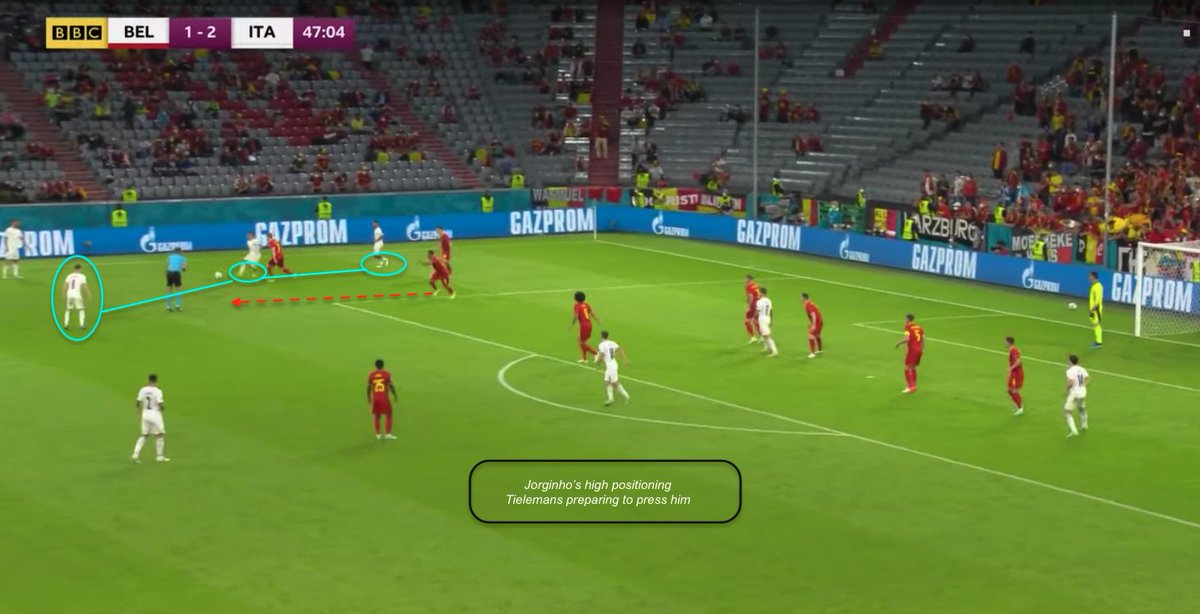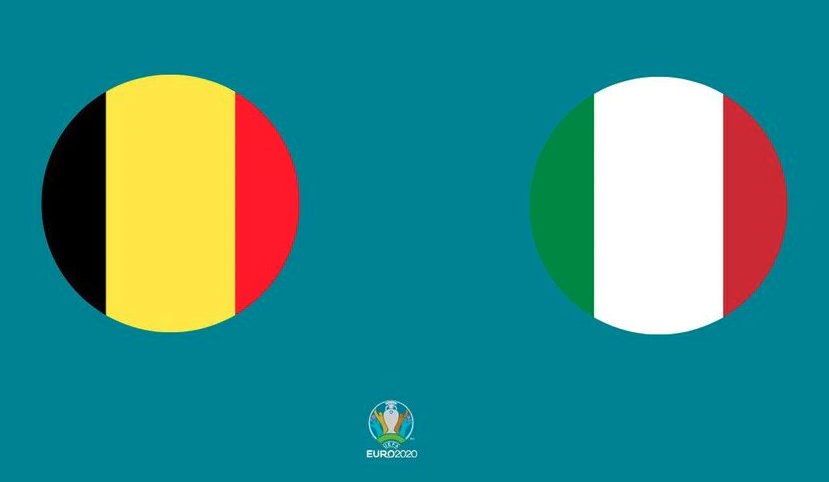0-15'
We have here two different pressing patterns. Italy's one, very agressive, coordinated, even risky sometimes due to spaces left from midfielders' deep runs. It forces Belgium to play wide and long balls.

We have here two different pressing patterns. Italy's one, very agressive, coordinated, even risky sometimes due to spaces left from midfielders' deep runs. It forces Belgium to play wide and long balls.


Concerning Belgium's pressing, more based on placement (De Bruyne as a false 9, Lukaku and Doku as wingers ready to apply deep runs behind the defense)
Always individual marking on key player in build up (Jorginho).
Always individual marking on key player in build up (Jorginho).

Verratti knew organization issues from Belgium's midfield concerning its off-ball positioning. This kind of corridor happened many times during these 90 minutes. It could have troubled far more if Italy had been able to take advantage of this. 



To counter this low block, Italy implemented a relevant strategy : Verratti and Jorginho (especially during 2nd half) took it a step further to create this malleable triangle and have a constant 3V3 opposition, which jeopardized Belgium a lot. 



Now lets have a look on both teams off-ball defensive animation: concerning Belgiums, tightened lines, 5-3-2 when the ball is in their mid 3rd, and a 3-4-3 when the ball is in their attacking 3rd
KDB's role was to watch on Jorginho when he was back to goal
KDB's role was to watch on Jorginho when he was back to goal

Italy's off ball animation had two main objectives : trap Tielemans, key player concerning breaking lines with vertical passes, and force ball carrier to play wide. KDB is individually marked and has few possibilities to get the ball 



15-30'
Both teams have two sublime strikers concerning back to goal behavior. This time, Immobile and Lukaku failed many passes that led to dangerous counter attacks and allowed vertical transitions. Two examples below⤵️
Both teams have two sublime strikers concerning back to goal behavior. This time, Immobile and Lukaku failed many passes that led to dangerous counter attacks and allowed vertical transitions. Two examples below⤵️
Lukaku's back to goal pass unprecise
Barella's ability to break lines thanks to Wistel's useless pressure
Wide open area for Insigne and Immobile


Barella's ability to break lines thanks to Wistel's useless pressure
Wide open area for Insigne and Immobile



Immobile 3V1 difficult to deal with
Alderweireld's anticipation
Jorginho constrained to press KDB
Wide open space for Lukaku and a dangerous 3V3



Alderweireld's anticipation
Jorginho constrained to press KDB
Wide open space for Lukaku and a dangerous 3V3




Belgium's rare fast transitions were always dangerous, and Lukaku played a central role in it, doing diagonal runs in order to attract Chiellini and let the space wide open for KDB to shoot. 



30-45'
During this tournament, Insigne-Spinazzola's pair has been one of the most efficient of the Euro. Let's focus on how this associations works.
First of all, in their mid 3rd :high positioning, inverted positions, waiting for Bonucci's accuracy.
During this tournament, Insigne-Spinazzola's pair has been one of the most efficient of the Euro. Let's focus on how this associations works.
First of all, in their mid 3rd :high positioning, inverted positions, waiting for Bonucci's accuracy.

In the attacking third, traditional central repositioning of Insigne, but still keeping a reachable passing angle to Spina.
Opponent's defensive organization is troubled due to this very high position of Spinazzola.
Opponent's defensive organization is troubled due to this very high position of Spinazzola.

45-60'
Same objectives for Italy's midfield : counter this low block by creating this malleable triangle as shown in the first part of this thread. This time, Jorginho is the key part of this triangle.

Same objectives for Italy's midfield : counter this low block by creating this malleable triangle as shown in the first part of this thread. This time, Jorginho is the key part of this triangle.


In addition, this triangle creation is confirmed by Jorginho's passing area, located on this left side on the pitch (source : @CalcioDatato) 

60-75'
Another way to counter Belgium's low block that Portugal didn't manage to : Finding passing angles from full-backs. Di Lorenzo is a key asset concerning this discipline.

Another way to counter Belgium's low block that Portugal didn't manage to : Finding passing angles from full-backs. Di Lorenzo is a key asset concerning this discipline.


Concerning Belgium's pressing during this second half, far higher, more accompanied by Witsel and Tielemans, not letting Jorginho or Verratti feeling free to move and pass the ball 

How to keep the ball high and under pressure? Jorginho and Verratti gave us many answers, including this one, with one touch passing. 



Italian fullbacks, as we have seen, use to place into a high position to jeopardize defensive organization.
But in case of counter attack, tactical replacement is remarkable
But in case of counter attack, tactical replacement is remarkable
75-90'
Need to speak about Doku's driblling skills : provoked one penalty, and unbalanced italian's defense, when belgiums pushed to get a draw. This young player was far more efficient concerning breaking lines with dribbles and runs than Hazard.
Need to speak about Doku's driblling skills : provoked one penalty, and unbalanced italian's defense, when belgiums pushed to get a draw. This young player was far more efficient concerning breaking lines with dribbles and runs than Hazard.
Even if each belgium attack has been dangerous, this low block pattern limited the potential of their creators like De Bruyne or Tielemans. Pass combinations is a good example to showcase as well (Source : @__ElJdP ) 

• • •
Missing some Tweet in this thread? You can try to
force a refresh























